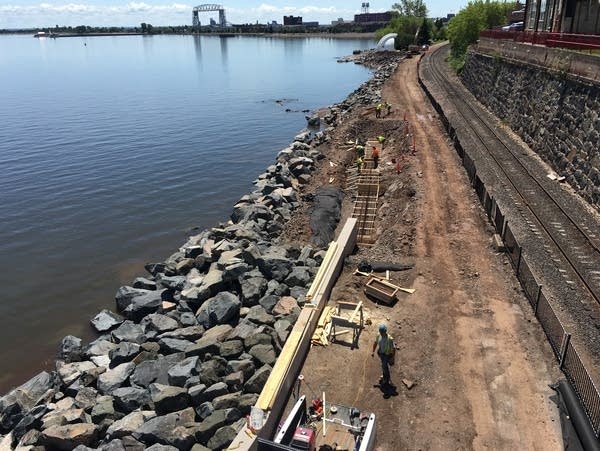Storms pounded Duluth's shoreline, but there was a silver lining

Go Deeper.
Create an account or log in to save stories.
Like this?
Thanks for liking this story! We have added it to a list of your favorite stories.
For the third October in a row, Duluth officials are cleaning up after a major storm caused giant waves to rip up streets and flood infrastructure. The city along Lake Superior is working to rebuild in a way that is more resilient to future storms. Early results from this storm show those efforts are paying off.
In Canal Park, behind a row of hotels, winds on Monday that exceeded 60 miles per hour created waves over 10 feet high, washed up rocks and large logs approximately 50 feet up the shore.
It’s a familiar sight to Duluth officials.
"I had been waiting for this moment and unfortunately, I kind of predicted it. We were due. It’s almost like clockwork, every six months," said Mike LeBeau, the city’s construction projects supervisor.
Turn Up Your Support
MPR News helps you turn down the noise and build shared understanding. Turn up your support for this public resource and keep trusted journalism accessible to all.
Duluth was battered by a major storm in April, and another one last October, when winds and high waves caused almost $20 million in damage. That storm was a near rerun of one in October 2017. In some cases, wind and waves destroyed infrastructure the city had recently repaired.
So LeBeau says the city is building more resilient infrastructure that can withstand severe weather in the future. "We can’t hold back the power of the lake and those storms. But what we did, I think, is build something that can withstand that without being damaged."
He pulls out his phone and clicks on a video from Monday. Giant waves crash over a section of the popular Lakewalk pedestrian trail the city finished reconstructing this summer.
But instead of just rebuilding it the same way, crews placed massive boulders between the trail and the lake to absorb the force of the big waves. Then they sunk a thick concrete wall to provide further protection. LeBeau inspected it Tuesday to see how it held up.

"And everything looked perfect, so it was really satisfying and encouraging that we have reached the answer to the shoreline," he said.
Lake Superior is legendary for its ship-sinking storms, especially in the fall. But the shoreline damage in recent years has been compounded by historically high water levels. The big lake tied its record high monthly level in September, some 14 inches above normal, based on records going back 100 years.
"So now with the water levels as high as they are, when you get any sort of a northerly, northeasterly component to the wind, that shoves the water from the open lake into the Duluth area and creates very large waves that now break higher up on the shoreline than they were during lower water periods," said Keith Kompoltowicz, chief of watershed hydrology, U.S. Army Corps of Engineers in Detroit.
He said storms are damaging shoreline infrastructure around the Great Lakes. The high water levels are fueled by record rainfall over the past several years. The five-year period ending September 30 is the wettest on record for the Great Lakes basin, dating back 125 years.
And more large rain storms are forecast for the Upper Midwest as the climate warms. But there's still uncertainty over what climate change will mean long-term for Great Lakes water levels. That's because warmer temperatures also lead to more evaporation.
Duluth officials are trying to prepare for that uncertainty by building a more climate resilient Lakewalk. Early next year the city plans to begin hauling in 77,000 thousand tons of boulders to protect a new section of Lakewalk it plans to build in Canal Park, the same stretch buried in debris this week.
Jim Filby Williams, Duluth’s director of public administration, said the city is moving as fast as it can to build more durable infrastructure “to endure not only the frequency and severity of storms our forebears saw, but the frequency and severity we’re likely to see 50 years from now.”
The new half-mile section of Lakewalk in Canal Park is expected to cost $10 - 15 million.
Beth Gibbons, an expert in climate resilience who directs the American Association of Adaptation Professionals, said cities around the country are beginning to take a long-term approach to their infrastructure needs.
"It might have cost more to rebuild that Lakewalk in a more resilient way this year or in 2017” Gibbons said. “But if it withstood the storm that you just experienced, then what was that cost benefit?"
Meanwhile, Duluth officials are crossing their fingers there's not another big storm this year, even as the traditionally stormy November approaches.
Dear reader,
Your voice matters. And we want to hear it.
Will you help shape the future of Minnesota Public Radio by taking our short Listener Survey?
It only takes a few minutes, and your input helps us serve you better—whether it’s news, culture, or the conversations that matter most to Minnesotans.




